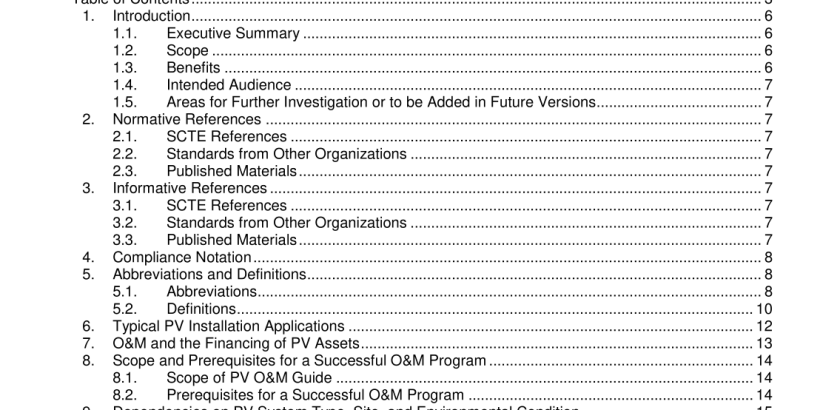ANSI SCTE 246-2018 pdf download.Best Practices in Photovoltaic System Operations and Maintenance for Cable System Operator
1.1. Executive Summary
This document provides recommended best practices for photovoltaic system operations and maintenance. This guide may not include all operations and maintenance routines or scenarios, but provides general guidance for safety practices, management, operations, and preventative maintenance of PV systems. Solar Photo Voltaic (PV) power generation systems in cable facilities are becoming more prevalent. There are several factors impacting the deployment of these PV systems including, high cost of electricity, reduced reliability of the electrical grid, national, state and utility incentives, carbon reduction and sustainability goals. Solar PV is operational during daylight hours for base, intermediate or peak load power generation replacing kW/MW normally supplied by the local utility. PV power generation systems are typically deployed to reduce the amount of power consumed that is generated from burning fossil fuels and increase the amount of power consumed by renewable energy sources. Most PV systems can reduce grid dependency with the addition of energy storage and provide relief for the electrical grid during high consumption periods. When electrical grids are under the most strain due to high consumption is also the time period the solar systems are operating at peak output.
Roof mounted PV systems are the most deployed systems at cable facilities. Ground mounted systems utilize valuable ground space and, in most locations, facility ground space is limited. Utilization of reclaimed ground space, such as decommissioned satellite dish space, is an option for deploying ground mounted systems. PV systems require periodic, scheduled maintenance to maintain reliability and operational efficiency. One of the most important areas of an O&M program is safety. Only qualified and trained personnel or contractors should be permitted to service or maintain PV systems. The most dangerous parts of a solar electric system is the electricity generated by the PV system. Personal protective equipment for arc-flash protection, lock-out/tag-out procedures, and rooftop safety are required when working around PV systems. Keeping contractors and/or employees as safe as possible by preparing them for prevention of hazards and fall risks associated with PV systems.
Ensures efficient, safe, and reliable process operations including making decisions about maintenance actions based on cost/benefit analysis. This includes serving as a point of contact for personnel regarding operation of the PV system; coordinating with others regarding system operation; power and energy forecasts; scheduling maintenance operations; spare parts inventory (either in-stock on-site or in suppliers’ consignment stock); and inspecting work and approving invoices. Meanwhile, operations include any day-to-day operation of the system to maximize power delivery; performance assessment and trends; operation of grid interface; manage curtailments; or adjust settings such as power factor or other ancillary services. Directions for the performance of work Specifies the rules and provisions to ensure that maintenance is performed safely and efficiently, including the formalization and enforcement of: safety policy (including training for DC and AC safety, rooftop safety, minimum staffing requirements, arc flash, and lock-out tag-out); work hours; site access, laydown areas, and parking; and any other stipulations under which work is performed. This includes confirming and enforcing qualifications of service providers, as well as compliance with any environmental or facility-level policies regarding the handling of controlled materials (e.g., solvents, weed killer, insecticide). Monitoring System analysis of resulting data to remain informed on system status; metering for revenue; alarms; diagnostics; and security monitoring. Includes comparing results of system monitoring to benchmark expectation and providing reports to facility stakeholders. This includes periodically preparing reports as required by O&M contract or as required by the system owner including reports of plant performance; key performance indicators; problems and alarms, and maintenance services performed. Site security is performed both locally and with remote monitoring (cameras, intruder alarms) to protect against theft and vandalism. ANSI SCTE 246-2018 pdf download
